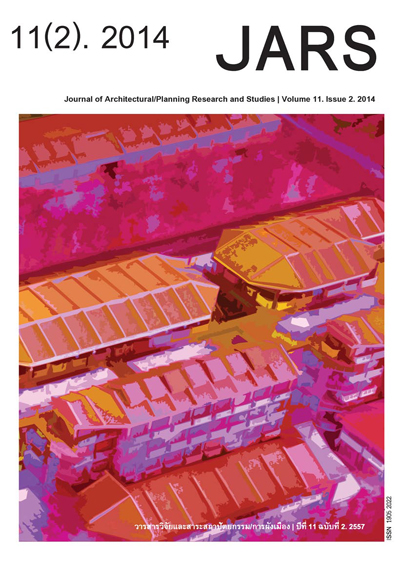Impact of Urban Heat Island on Daily Life of People in Bangkok Metropolitan Region (BMR)
Main Article Content
Abstract
The climate change have been obtained the much attention worldwide in order to launch the mitigation policy and implementation for alleviate this crisis. From the statistical data in 2013 found that an average temperature of Bangkok Metropolitan Region area was 36 degrees Celsius which is higher than an average temperature of suburban area around 3 degrees Celsius. This phenomenon is affecting to daily lives of humans’ which was influence by number of population, economics, and urban density. This study attempted to assess transportation behavior and daily life activity (electricity and energy consumption), including, an attitude on the advertising and law or regulation which promote energy consumption reduction. The cause of the improper behavior would be examined by exploring different area of Bangkok Metropolitan Region (suburban, center area, and central business district). This study conducted the 675 questionnaires survey for data collection and applying logistic regression analysis method is finding a relationship of the influencing factors. The result of study demonstrated that the public transport users have a positive attitude since a most of people agree by adopting public transportation as a main mode in daily transportation for energy reduction and reduction carbon dioxide emissions. Therefore, to mitigate the problematic of Urban Heat Island, the city should launch campaign to raise people awareness and motivation for change the individual behavior and attitudes on both travel pattern and daily activity. The approach would be an attractive to mitigate Urban Heat Island problem and reach to the livable.
Downloads
Article Details

This work is licensed under a Creative Commons Attribution-NonCommercial-NoDerivatives 4.0 International License.
All material is licensed under the terms of the Creative Commons Attribution 4.0 International (CC-BY-NC-ND 4.0) License, unless otherwise stated. As such, authors are free to share, copy, and redistribute the material in any medium or format. The authors must give appropriate credit, provide a link to the license, and indicate if changes were made. The authors may do so in any reasonable manner, but not in any way that suggests the licensor endorses you or your use. The authors may not use the material for commercial purposes. If the authors remix, transform, or build upon the material, they may not distribute the modified material, unless permission is obtained from JARS. Final, accepted versions of the paper may be posted on third party repositories, provided appropriate acknowledgement to the original source is clearly noted.
References
Bass, B. & Baskaran, B. (2003). Evaluating rooftop and vertical gardens as an adaptation strategy for urban areas (Research report). Toronto, Canada: National Research Council & Conseil national de recherches.
Department of Mineral Fuels. (2010). 40 ปี ของกฎหมายปิโตรเลียมไทย [40 Year of Thai laws petroleum].Bangkok: Ministry of Energy.
Duffy, J. F., Dijk, D-J., Hall, E. F. & Czeisler, C. A. (1999). Relationship of endogenous circadian melatonin and temperature rhythms to self-reported preference for morning or evening activity in young and older people. Journal of Investigative Medicine, 47, 141-150.
Freud, S. & Bonaparte, M. (2010). The origins of psycho-analysis: Letters to wilhelm fliess, Drafts & Notes 1887-1902. United States: Kessinger Publishing.
Fuchs, D. (2005). Spain goes hi-tech to beat drought. Retrieved June 20, 2014, from http://www.guardian.co.uk/weather/Story/0.2763.1516375.00.html
Hosmer, D. W., Lemeshow, J. S. & Sturdivant, R. X. (1989). Applied logistic regression. New York, United States:John Wiley & Sons.
Jitdon, R. (2013). โดมความร้อน [Heat Island]. Bangkok: Hrdro and Agro Infornatics Institute.
Kalkstein, L. S. & Sheridan, S. C. (2003). The impact of heat Island reduction strategies on health-debilitating oppressive air masses in urban areas (Research report). United States: Environmental Protection Agency.
Matlin, M.W. (1995). Psychology. Texas: Harcourt Brace College Publishers.
Ministry of Energy. (2011). แผนอนุรักษ์พลังงาน 20 ปี (พ.ศ. 2554 - 2573) [20 Years of energy policy and planning]. Bangkok: Author.
Oke, T. R. (1982). The energetic basis of the urban heat island. Quarterly Journal of the Royal Meteorological Society, 108(455), 1-24.
Oke, T. R. (1995). The heat island of the urban boundary layer: Characteristics, causes and effects. In J.E. Cermak, A.G. Davenport, E.J. Plate & D.X. Viegas (Eds). Wind Climate in Cities. (pp. 81-107). Netherlands: Kluwer Academic.
Ricker, W. E. (1973). Linear regressions in fishery research. Journal of the Fisheries Research Board of Canada, 30(3), 409.434.
Santrock, J. W. & Halonen, J. S. (1993). Psychology: The contexts of behavior. Dubuque, IA: Brown and Benchmark.
South Dakota Department of Agriculture. (2008). Urban & community forestry comprehensive challenge grants. Retrieved January 18, 2014, from https://sdda.sd.gov/conservation-forestry/grants-loans/community-forestry-challenge-grants/
Taha, H. (1997). Urban climates and heat islands: albedo, evapotranspiration, and anthropogenic heat. Energy and Buildings, 25(2), 99-103.
Teanmanee, T. (2002). ปรากฏการณ์เกาะความร้อนกับสภาพทางกายภาพของเมือง [Urban heat island and physical environment]. Master of Architecture Thesis, Department of Urban Design and Planning, Silpakorn University, Bangkok, Thailand.
Khongouan, W. & Sakulrattanakulchai, S. (2014). แนวทางการส่งเสริมการใช้จักรยานภายในมหาวิทยาลัย: กรณีศึกษา มหาวิทยาลัยเกษตรศาสตร์ มหาวิทยาลัยมหิดล และมหาวิทยาลัยธรรมศาสตร์ [Guidelines to promote cycling on University campus: Case Study of Kasetsart University, Mahidol University and Thammasat University]. Journal of Architectural/Planning Research and Studies, 11(1), 59-72.
Thai Meteorological Department. (2013). สภาพอากาศประเทศไทย [Thailand weather]. Bangkok: Author.
Weihrich, H. & Koontz, H. (1993). Management: A global perspective. New York, United States: McGraw-Hill.


